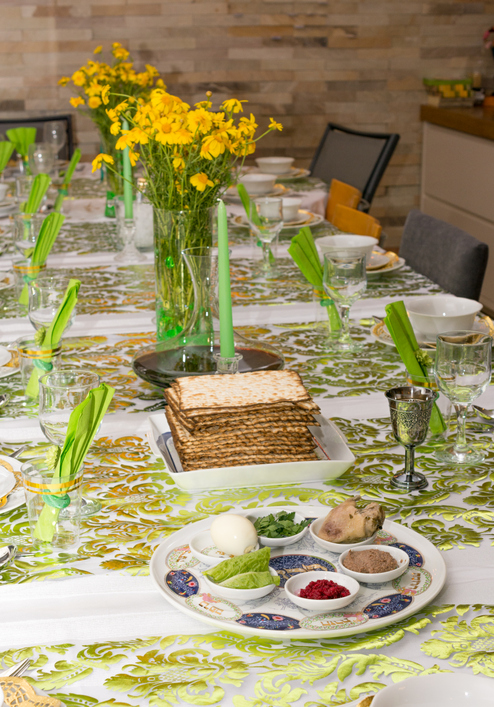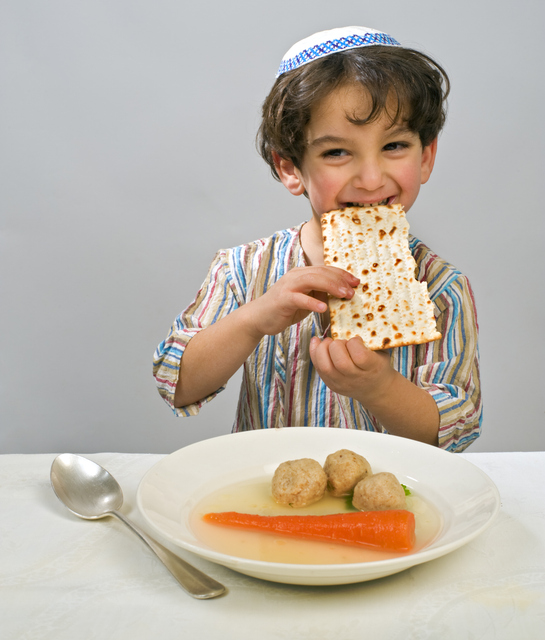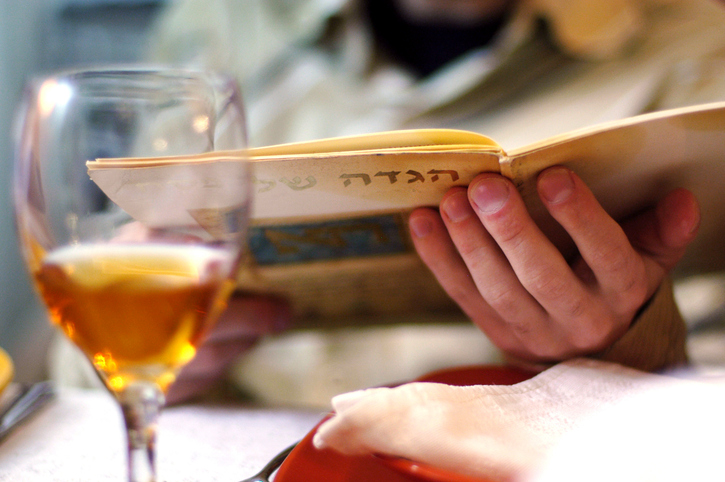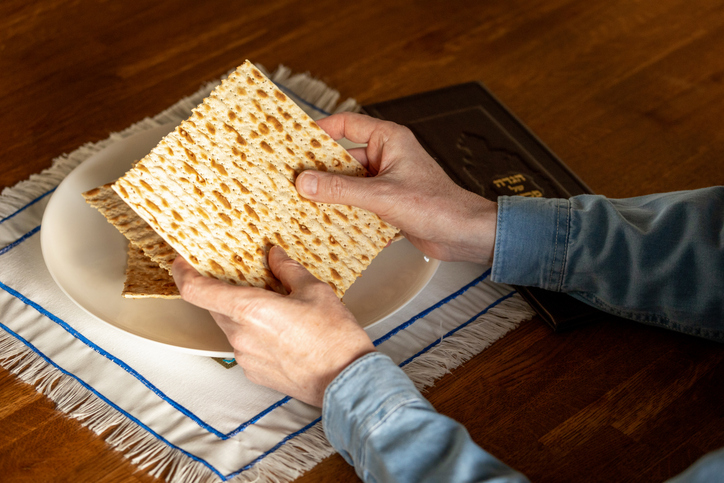
Keeping Children Engaged at the Seder Without Losing Your Mind
According to a study published in the Lancet in 1988, the male Jewish death rate drops during the week before the Passover Seder and picks up again the following week. The conclusion drawn by the authors was that the will to live was strong enough to delay mortality in men who were eagerly looking forward to the occasion. Although the same effect is seen around individual birthdays, Passover is the only Jewish holiday where this effect has been measured. Why?
Rabbi Yakov Saposh of the Aberdeen Torah Kollel quotes Nachmanides to the effect that the miracles performed by Moses before Pharaoh convinced humanity that creation was of Divine origin and not simply a natural occurrence. The exodus from Egypt is thus the event from which all faith arises, as we are reminded every Friday night when we say Kiddush, and the first step in our becoming a nation with our own calendar and our own land. Strengthening these connections underlies our focus on children. In addition to the direct command in the Torah to “tell your child on that day,” Ex. 13:8, the Seder is the only event in which the Gemara expressly addresses how to integrate children into an event, whether it is preferable to give them wine or to give them candy, Pesachim 108b and why, ibid 114b and 115b. “Why we are dipping, why we are removing the Seder plate is that we want the children to ask,” said Rabbi Saposh. “It is in order to get them involved.”
 Of course, if deriving the answers to the four questions were all that it took to get children involved with—and attentive to—the proceedings, this would be a very short article, indeed. The first question that adults may ask is if, in fact, a child is ready to participate at all.
Of course, if deriving the answers to the four questions were all that it took to get children involved with—and attentive to—the proceedings, this would be a very short article, indeed. The first question that adults may ask is if, in fact, a child is ready to participate at all.
Dr. Gadi Fortune, a New Jersey psychologist, points out that it is difficult to generalize because so much depends on the individual child. “It also depends on the duration of the Seder,” he added. By four or five years old, most children are able to participate to some extent. “A good behavioral marker is if the child can sit in class, or if the child is willing to engage.” Once you’ve answered that question, there are a number of things you can do to boost your chances of success.

Participation should begin long before the Seder, preferably as soon as the Purim costumes are put away. Preparations, whether they involve housecleaning, food shopping and cooking or gift shopping, packing and traveling can be treated as buildups to an exciting event instead of the stressful chores they can at times seem. Pointing this out with excitement can build anticipation that will color the event in the child’s mind. Even more so, ownership of some part of the Seder will give the child a stake in the proceedings and make him much more likely to see it through. If the child likes crafts, matzah covers can be made of cloth with fabric paints or glued on felt appliques or can be woven, crocheted, knitted or hemmed and embroidered. The underside of a cheap, transparent plastic tray can be painted to turn it into a Seder plant or matzah tray. There are endless ways to make placemats, place cards and menu cards out of paper. Napkin rings can be made out of painted, sliced cardboard paper towel holders. Painted jar lids can make wine coasters—maybe not what you had in mind for your wedding Waterford, but a source of pride for an otherwise skittish participant. Any preparations the child can make on the day of the Seder—from tearing the lettuce, to setting the table, to acting as sous chef—can reinforce this sense of ownership.
 At the same time, the Seder itself should receive attention. Rabbi Saposh quotes the Talmud to the effect that “the Seder should be concise, to the point and short.” What is short to a Talmudist, however, is not necessarily the same to a child, and much of the Haggadah is taken up with narratives and explanations that are too discursive for a child to follow. Reviewing the structure of the Seder beforehand may make it seem to go faster, for adults as well as children. A children’s Haggadah can be a real help here. There are many online from which to choose, and getting a child one that he has asked for and that you can go over with him first can be the beginning of true involvement.
At the same time, the Seder itself should receive attention. Rabbi Saposh quotes the Talmud to the effect that “the Seder should be concise, to the point and short.” What is short to a Talmudist, however, is not necessarily the same to a child, and much of the Haggadah is taken up with narratives and explanations that are too discursive for a child to follow. Reviewing the structure of the Seder beforehand may make it seem to go faster, for adults as well as children. A children’s Haggadah can be a real help here. There are many online from which to choose, and getting a child one that he has asked for and that you can go over with him first can be the beginning of true involvement.
On the day of the Seder, pick your battles. Be as indulgent as possible before sitting down. If your child wants to wear sequins when you want her in pajamas, let it go. If he wants to wear a Yankees cap rather than an embroidered kippah, let it go if you can. A disappointed child is going to become a cranky child much earlier than an eager one. That said, once a child reaches the age of eight or nine, some pre-Seder bribery may be in order. “You may have to negotiate,” said Dr. Fortune.
One item to add to the table, along with the Seder plate, salt water and matzah is a plate of cut up fruit. Even the fastest Seder may mean a long time for a smaller stomach to remain empty, and fruit can restore the mood without a sugar spike and without killing the appetite for what comes later.
 Unfortunately, even the best preparation cannot turn protracted sitting and listening into an enjoyable experience, a fact that was no doubt discovered not long after the first few Seders in the desert, which is why we spend much of the Seder singing songs. Lots of songs. Check out YouTube for Passover songs that you can learn before the Seder. Play them until your children learn them, too.
Unfortunately, even the best preparation cannot turn protracted sitting and listening into an enjoyable experience, a fact that was no doubt discovered not long after the first few Seders in the desert, which is why we spend much of the Seder singing songs. Lots of songs. Check out YouTube for Passover songs that you can learn before the Seder. Play them until your children learn them, too.
There are also traditions, especially among Sephardim, that involve acting out parts of the Seder. One tradition involves guests’ marching around the table after the splitting off of the afikomen with pieces of matzah held on their shoulders to signify leaving Egypt with the unleavened bread. Another involves Seder participants’ striking one another with scallions or leeks while singing Dayenu because the Hebrew slaves were whipped by their Egyptian taskmasters. Even if these are not your traditions, you can adapt them if they are likely to enhance the Seder, or use the Haggadah for additional dramatic inspiration. Sock puppets or papier mache finger puppets of the characters of the Haggadah can be easily made beforehand and strategically deployed. There is also Seder bingo: a card marked off in squares, each indicating a milestone of the Seder with buttons, if there are no children around under three, or a washable marker to indicate when each point was reached.
And, of course, there is the afikomen. For younger children, pieces of the afikomen can be hidden and the children given prizes for finding them. For those a bit older and thus contemptuous of what they consider kids’ games, the afikomen hunt can be reframed as an opportunity for some gentle extortion. Emphasizing how important the afikomen is and announcing that therefore it will be put away for safekeeping may awaken enough larcenous calculation as to refresh an otherwise anti-authority, not to mention impatient, participant.
Particularly with young children, there may come a time during the proceedings when engagement is a lost cause, but the hope for peace and quiet has not yet been abandoned. According to Dr. Fortune, “the best distraction is another child.” Children who are close to the same age will entertain one another. If they want to run off to play and can do so safely, let them go, and thank Heaven for cousins. If none are available, at this point, distraction in situ is what will probably work best.
Accept the fact that the child is not going to be paying much attention to the proceedings and that next year is another year. Then try to accommodate his interests with a minimum of mess. A large placemat cut from butcher paper can protect the tablecloth without drawing the kind of attention that putting down newspaper would. Kosher for Passover playdough can be made from baking soda, water and potato starch. Crayons can do very little damage, but if only paints will do, use water colors. Bibs, or course, are de rigueur.
So, what do the pros do? Rabbi Saposh uses candy. He asks questions, and whoever answers correctly gets a piece of candy. And, whoever answers incorrectly gets a piece of candy. And, whoever asks a question gets a piece of candy.
Dr. Fortune tries to adjust the Seder to the level of the child. “You can try to condense the Seder to one hour,” he said, “but frankly, if he can sustain that attention for even twenty minutes without being too hyper, that is a win.”
Sue Kleinberg is a contributing writer to Jlife Magazine.







